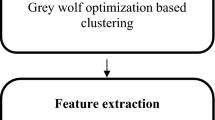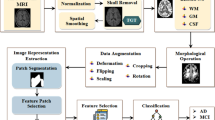Abstract
Alzheimer is an advanced nervous brain disease. In old aged people, Alzheimer is also causing the death. The earlier prediction of Alzheimer’s disease (AD) helps to proper treatment and protects from brain tissue damages. In earlier works, different machine learning techniques are presented and the techniques are lacks in the detection performance. This work presented an innovative methodology for the Alzheimer detection in brain image. Initially, an input image is pre-processed by the skull stripping, and normalized linear smoothing and median joint (NLSMJ) filtering. In the next stage, grey matter (GM), white matter (WM) and cerebrospinal fluid (CSF) brain regions are segmented from the filtered images using adaptive fuzzy based atom search optimizer which is the high convergence rate optimizer for enhancing the segmentation performance. After the image segmentation, GM is registered with the filtered images using the improved affine transformation. Subsequently, features are extracted utilizing improved Zernike features and hybrid wavelet walsh features. Afterwards, features are selected utilizing adaptive rain optimization. Finally, hybrid equilibrium optimizer with capsule auto encoder (HEOCAE) framework is utilized for the detection of Alzheimer, normal and mild cognitive impairment images. The implementation platform used in this work is MATLAB. The presented technique is tested with the ADNI dataset images. The experimental results of the presented technique provide improved performance than the existing techniques in regards of accuracy (98.21%), sensitivity (97.31%), specificity (98.64%), precision (97.45%), NPV (0.098), F1 measure (97.37%) and AUC score (98.29%).






















Similar content being viewed by others
References
Acharya UR, Fernandes SL, WeiKoh JE, Ciaccio EJ, Fabell MKM, Tanik UJ, Rajinikanth V, Yeong CH (2019) Automated detection of Alzheimer’s disease using brain MRI images–a study with various feature extraction techniques. J Med Syst 43(9):1–14
Altaf T, Anwar S, Gul N, Majeed N, Majid M (2017) Multi-class Alzheimer disease classification using hybrid features. In: IEEE future technologies conference
Altaf T, Anwar SM, Gul N, Majeed MN, Majid M (2018) Multi-class Alzheimer’s disease classification using image and clinical features. Biomed Signal Process Control 43:64–74
Amini M, Moradi A, Jamshidi M, Ouchani M (2021) Single and combined neuroimaging techniques for Alzheimer’s disease detection. Comput Intell Neurosci 2021:1–22
Baskar D, Jayanthi VS, Jayanthi AN (2019) An efficient classification approach for detection of Alzheimer’s disease from biomedical imaging modalities. Multimed Tools Appl 78(10):12883–12915
Billones CD, Demetria OJLD, Hostallero DED, Naval PC (2016) DemNet: a convolutional neural network for the detection of Alzheimer’s disease and mild cognitive impairment. In: 2016 IEEE region 10 conference (TENCON). IEEE, pp 3724–3727
Chen K, Franko K, Sang R (2021) Structured model pruning of convolutional networks on tensor processing units. arXiv preprint arXiv:2107.04191
Chyzhyk D, Savio A, Graña M (2014) Evolutionary ELM wrapper feature selection for Alzheimer’s disease CAD on anatomical brain MRI. Neurocomputing 128:73–80
Derby CA (2020) Trends in the public health significance, definitions of disease, and implications for prevention of Alzheimer’s disease. Curr Epidemiol Rep 7(2):68–76
Duraisamy B, Shanmugam JV, Annamalai J (2019) Alzheimer disease detection from structural MR images using FCM based weighted probabilistic neural network. Brain Imaging Behav 13(1):87–110
Feng J, Zhang S-W, Chen L, Xia J (2021) Alzheimer’s disease classification using features extracted from nonsubsampled contourlet subband-based individual networks. Neurocomputing 421:260–272
Grassi M, Rouleaux N, Caldirola D, Loewenstein D, Schruers K, Perna G, Dumontier M (2019) A novel ensemble-based machine learning algorithm to predict the conversion from mild cognitive impairment to Alzheimer’s disease using socio-demographic characteristics, clinical information, and neuropsychological measures. Front Neurol 10:756
Gupta Y, Lama RK, Kwon G-R, Weiner MW, Aisen P, Weiner M, Petersen R et al (2019) Prediction and classification of Alzheimer’s disease based on combined features from apolipoprotein-E genotype, cerebrospinal fluid, MR, and FDG-PET imaging biomarkers. Front Comput Neurosci 13:72
Islam J, Zhang Y (2017) A novel deep learning based multi-class classification method for Alzheimer’s disease detection using brain MRI data. In: International conference on brain informatics. Springer, Cham, pp 213–222
Islam J, Zhang Y (2018) Brain MRI analysis for Alzheimer’s disease diagnosis using an ensemble system of deep convolutional neural networks. Brain Inform 5(2):1–14
Islam J, Zhang Y (2018) Brain MRI analysis for Alzheimer’s disease diagnosis using an ensemble system of deep convolutional neural networks. Brain Inform 5(2):2
Janghel RR, Rathore YK (2020) Deep convolution neural network based system for early diagnosis of Alzheimer’s disease. IRBM 42:258–267
Khan RU, Tanveer M, Pachori RB (2021) A novel method for the classification of Alzheimer’s disease from normal controls using magnetic resonance imaging. Expert Syst 38(1):e12566
Kruthika KR, Maheshappa HD (2019) CBIR system using capsule networks and 3D CNN for Alzheimer’s disease diagnosis. Inform Med Unlocked 14:59–68
Lee G, Nho K, Kang B, Sohn K-A, Kim D (2019) Predicting Alzheimer’s disease progression using multi-modal deep learning approach. Sci Rep 9(1):1–12
Liu C-F, Padhy S, Ramachandran S, Wang VX, Efimov A, Bernal A, Shi L et al (2019) Using deep Siamese neural networks for detection of brain asymmetries associated with Alzheimer’s disease and mild cognitive impairment. Magn Reson Imaging 64:190–199
Liu M, Li F, Yan H, Wang K, Ma Y, Shen L, Xu M (2020) A multi-model deep convolutional neural network for automatic hippocampus segmentation and classification in Alzheimer’s disease. NeuroImage 208:116459
Mehmood A, Maqsood M, Bashir M, Shuyuan Y (2020) A deep siamese convolution neural network for multi-class classification of Alzheimer disease. Brain Sci 10(2):84
Nawaz A, Anwar SM, Liaqat R, Iqbal J, Bagci U, Majid M (2021) Deep convolutional neural network based classification of Alzheimer’s disease using MRI data. arXiv preprint arXiv:2101.02876
Ota K, Oishi N, Ito K, Fukuyama H, Sead-J Study Group, and Alzheimer’s Disease Neuroimaging Initiative (2015) Effects of imaging modalities, brain atlases and feature selection on prediction of Alzheimer’s disease. J Neurosci Methods 256:168–183
Poloni KM, de Oliveira IAD, Tam R, Ferrari RJ (2021) Brain MR image classification for Alzheimer’s disease diagnosis using structural hippocampal asymmetrical attributes from directional 3-D log-Gabor filter responses. Neurocomputing 419:126–135
Ramzan F, Khan MUG, Rehmat A, Iqbal S, Saba T, Rehman A, Mehmood Z (2020) A deep learning approach for automated diagnosis and multi-class classification of Alzheimer’s disease stages using resting-state fMRI and residual neural networks. J Med Syst 44(2):1–16
Raza M, Awais M, Ellahi W, Aslam N, Nguyen HX, Le-Minh H (2019) Diagnosis and monitoring of Alzheimer’s patients using classical and deep learning techniques. Expert Syst Appl 136:353–364
Ruiz E, Ramirez J, Górriz JM, Casillas J (2018) Alzheimer’s disease computer-aided diagnosis: histogram-based analysis of regional MRI volumes for feature selection and classification. J Alzheimers Dis 65(3):819–842
Sarraf S, Tofighi G (2016) Classification of Alzheimer’s disease using fMRI data and deep learning convolutional neural networks. arXiv preprint arXiv:1603.08631
Vu T-D, Ho N-H, Yang H-J, Kim J, Song H-C (2018) Non-white matter tissue extraction and deep convolutional neural network for Alzheimer’s disease detection. Soft Comput 22(20):6825–6833
Wen J, Thibeau-Sutre E, Diaz-Melo M, Samper-González J, Routier A, Bottani S, Dormont D et al (2020) Convolutional neural networks for classification of Alzheimer’s disease: overview and reproducible evaluation. Med Image Anal 63, 101694
Yue L, Gong X, Chen K, Mao M, Li J, Nandi AK, Li M (2018) Auto-detection of Alzheimer’s disease using deep convolutional neural networks. In: 2018 14th international conference on natural computation, fuzzy systems and knowledge discovery (ICNC-FSKD). IEEE, pp 228–234
Data availability statement
Data sharing not applicable to this article as no datasets were generated or analysed during the current study.
Author information
Authors and Affiliations
Corresponding author
Additional information
Publisher’s note
Springer Nature remains neutral with regard to jurisdictional claims in published maps and institutional affiliations.
Rights and permissions
About this article
Cite this article
Ansingkar, N.P., Patil, R.B. & Deshmukh, P.D. An efficient multi class Alzheimer detection using hybrid equilibrium optimizer with capsule auto encoder. Multimed Tools Appl 81, 6539–6570 (2022). https://doi.org/10.1007/s11042-021-11786-z
Received:
Revised:
Accepted:
Published:
Issue Date:
DOI: https://doi.org/10.1007/s11042-021-11786-z




